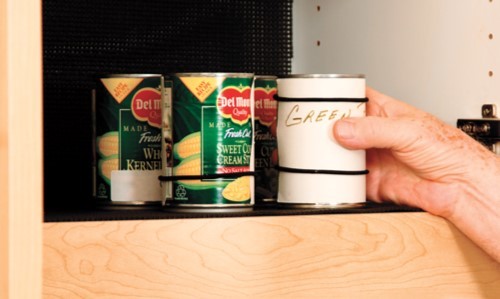Accessible Identification Systems for People Who Are Blind or Visually Impaired

As someone with a visual impairment, you will be faced with the question “What is this?” many times throughout the day. Often the answer is obvious (a fork); sometimes the answer comes with some comparison (an AA battery versus an AAA battery). Sometimes you can only make a partial identification (you know it’s a disk, but you don’t know if it’s music, video, or your computer’s backup disk). And then there are times when the answer is an utter mystery—“My friend sent me a birthday gift, and even with the box open, I still have no idea what it is.”
Along with maintaining independent travel, difficulty with accurately identifying items can be among the most frustrating problems for the newly blind. It can also be annoying, such as when you open a can of spinach when you meant to open a can of chili.
There are any number of low-tech methods that can help you keep things straight, such as putting one rubber band around your shampoo, and two around the bottle of conditioner. Braille labels can help keep your spice rack in order, and arranging your condiments alphabetically in the refrigerator door shelf (catsup, hot sauce, Italian dressing, mayonnaise, mustard, pickles, relish, Russian dressing, etc.) can help you locate the item you want. You can even keep your money sorted by using distinct folding patters for the different denominations in your wallet: the $1 bills are kept flat, the $5s are folded in half vertically, the $10s are folded lengthwise, the $20s are folded in quarters. Of course, these and other methods of everyday identification rely on having sighted assistance to help you mark, sort, or stow these items in the first place.
In this guide we will introduce you to several ways technology can help you identify everyday objects.
This article was written and published by the American Foundation for the Blind. <Click Here> to read the article in its entirety and access other helpful articles from AFB.
We Are Here To Bring Hope
If you or a loved one have been diagnosed with Macular Degeneration, we have prepared a 12-part eBook <Click here to download a PDF of the entire report.>
To learn more about how we can Bring Hope to people who are blind or with low vision, contact a Technology Specialist at New England Low Vision and Blindness to learn more. You can also call our toll free number 888-211-6933 or email us at info@nelowvision.com.
Our two(2) state-of-the-art technology showrooms are a wonderful resource, showcasing a variety of leading electronic low vision magnifiers and blindness products. You can schedule an appointment with one of our Technology Specialist who can help you find the right technology, training and care solution.
If you cannot come to us, our staff can even drive out and bring our Vision Store to you, for a no-obligation product demonstration. We offer a comprehensive line of products including electronic magnification low vision aids, blindness products, and leading low vision products for people with glaucoma, macular degeneration and other forms of vision loss.



